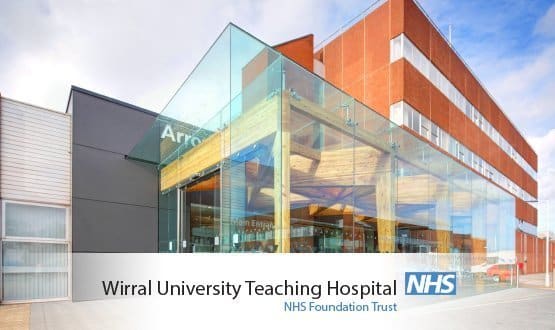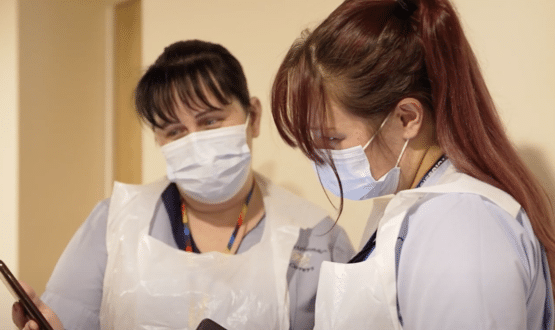Where there’s a Wirral, there’s a way
- 1 October 2015

As many NHS trusts face health secretary Jeremy Hunt’s 2020 deadline for a ‘paperless’ healthcare service with some trepidation, Wirral University Teaching Hospital NHS Foundation Trust is comfortably on its way, if not there already.
“Depending on Jeremy’s definition of what paperless is we are either there or nearly there,” says Mark Blakeman, director of informatics. “I’m not sure if it’s a really clear definition. But by most definitions, we will be there very soon.”
Situated on a peninsula between the River Dee and the River Mersey on the west coast of England, Wirral University Teaching Hospital has effectively been travelling on that journey for a quarter of a century, according to Blakeman
“For 25 years Wirral has been a leader in informatics,” he says, mentioning that the trust has had electronic prescribing for more than 20 years (putting it 20 years ahead of some trusts in England).
At the forefront
This pioneering outlook led to the appointment of the trust’s then chief executive Frank Burns as head of IM&T for the NHS in the 1990s, during which time he was the principal author for Information for Health – the 1998 information strategy that was superseded by the National Programme for IT, and the agency that ran it, Connecting for Health.
That desire to be at the forefront of NHS IT was also on display in 2010, when the trust sidestepped the national programme contract for electronic patient records in the North, Midlands and East by signing up with US firm Cerner and its Millennium product to a provide a single system EPR. https://www.digitalhealth.net/news/25926/
Wirral University Teaching Hospital already had a functioning clinical information system, but it was based on older technology and the trust wanted a system fit for the future. Five years later and Blakeman says that Wirral is now one of the leading Cerner sites in Europe.
But that doesn’t meant the trust can sit back while others fret about getting a working system in place or renewing contracts ahead of the close of the national contract in July 2016.
“We are really pleased to be through that phase of our development here and onto some interesting and exciting clinical phases, rather than just taking out a patient administration system and putting another one in,” says Blakeman.
“The fact we are through that now and well and truly miles ahead terms of clinical stuff is really fabulous. Everything we do now is around quality, safety and patient experience.”
Describing the impact of the Cerner, Blakeman says the use of a single system has allowed the trust to become a truly digital hospital, rather than one that uses electronic tools.
“What we are not doing is taking the nursing documentation that’s on paper and scanning it in and proclaiming it as being an EPR. Nor are we taking the nursing forms and getting people to type them in. This is about truly digital data; entering data once and using it multiple times.”
He mentions the majority of services are now fully digital in this way, from inpatient prescribing to maternity services to results reporting.
“Basically the only bit that’s not electronic is individual notes that clinicians write,” says Blakeman, although the trust is now working on using a range of technologies, including voice recognition and iPads, to support the process.
Making it fit
Wirral University Teaching Hospital’s status and leadership has helped it become something of an exemplar site for Cerner technology for the rest of the NHS.
“I think it would be fair to say we have been first of type for a lot of stuff,” says Blakeman, adding that the trust has been able to take “really cool” technology that works in Cerner’s US sites and make sure it works well in the UK as well.
“What we have proved over past five years is that by working well with a partner the system has been anglicised. That we have made it work really well for us as a healthcare organisation in the UK.”
An important factor has been having a strong team of in-house developers who have the capability to amend the system to fit the trust’s needs. A recent example of this is the development of an alerting system to detect people at risk of developing sepsis.
Dr Mark Hughes, consultant in intensive care medicine and anaesthesia sepsis lead, explains that the alerting system that was first presented to the trust wasn’t up to the job. It was only through bespoke development that it became a useful – and potentially life-saving – tool. “We have been able to shape it and develop it into what we want.”
The trust has also developed a tool to help clinicians identity acute kidney injury, says Sheila Stewart, associate director of informatics. “We have that capability in having a clever team of developers that can build things like that.”
This team allows the trust to keep improving in all of the ways it uses Millennium, says Hughes. “Come back in a year’s time and we’ll be that much further on for the whole system from where we are now. It’s an ongoing, developing thing.”
Regaining the crown
The trust’s most recent major IT development was the implementation of Cerner’s electronic prescribing and clinical documentation solutions last November, replacing legacy systems. https://www.digitalhealth.net/news/29742/wirral-prescribes-cerner-for-it-boost
At the time, Blakeman said he expected the tools would help the trust “regain the crown when it comes to really innovative use of IT.” Now, Stewart says the new systems have been “received extremely well”, adding that both prescribing and medicines administration are much easier.
The EPMA tool also gives clinicians access to a patients’ medication history, letting them see what medicines are due to be given, what’s overdue and any medicines that have been missed.
“Since that went live in November, we have noticed a real improvement in engagement with clinicians across the trust,” says Stewart.
Hughes agrees about the benefits Cerner’s EPMA system has over the trust’s previous PCIS tool. “It’s easier. And we can see what’s been given much more clearly.”
There are several more IT projects on the way, including chemotherapy electronic prescribing, barcoded medicines administration, and a portal to give patients access to their records.
An integrated model
The overall focus for the next few years will be on integration with Wirral’s wider health community. The trust is part of one of NHS England’s 37 ‘vanguard’ sites, set up to trial the new models of care that NHS England’s ‘Five Year Forward View’ hopes will help to plug £22 billion of the £30 billion gap between NHS funding and demand that could otherwise open up by 2020-21.
Under the banner Wirral Partners, Wirral University Teaching Hospital is working with Cheshire and Wirral Partnership NHS Foundation Trust, Wirral Community NHS Trust, Wirral Clinical Commissioning Group, Cerner and other partners on developing a model of integrated care across primary and secondary care providers, supported by a technology enabled population health model
The area has already made some headway in the area of joined up care through the use of Cerner’s electronic clinical exchange platform, Health Information Exchange, but that was just the first step.
“Our vanguard application was based on a strong partnership with other providers and commissioners across the whole health economy,” says Blakeman.
His ambition is to transfer the ideas behind the creation of a joined-up ‘digital hospital’ to an entire region. “If we take a similar view across whole health economy, we will be able to identify patients at risk of becoming sicker.
“And we can also make sure everybody across health economy is delivering the best practice for patients. We can have a real impact on patients’ lives outside hospital and inside.”
It’s a weighty ambition and it’s one that demonstrates Blakeman’s belief that the trust’s digital journey is far from over, despite it being a few steps closer to the 2020 goal than most.
“It’s a bit like learning to drive,” he says. “Very soon we will have our complete driving licence for our EPR. But when you are handed your licence, they say now you will really learn how to drive. We are now at that stage.”
It’s a point of view shared by Hughes: “It’s not like we are nearly finished. It’s like we are nearly at the start.”



